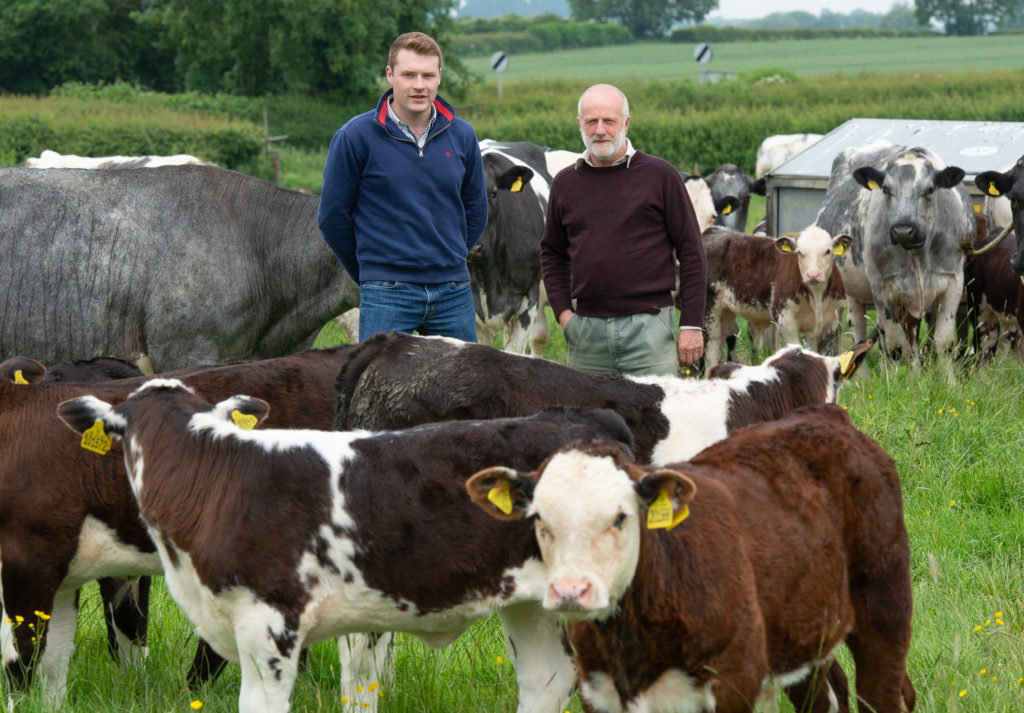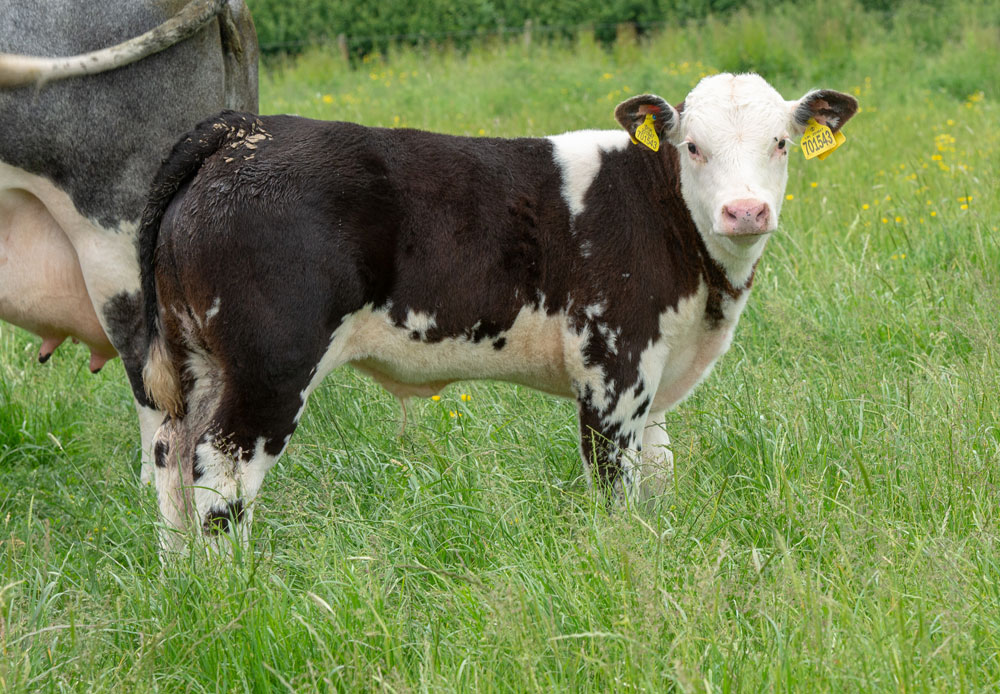
Previous studies at Harper Adams University with progeny from Limousin, Angus and Simmental bulls with different beef values/terminal indexes have shown significant improvements in performance with calves sired by the higher index bulls. To expand the database to confirm that EBVs ‘work’, a further study with Hereford sires was carried out on a commercial suckled-calf unit. The objective of this eighth study using Hereford bulls was to compare the performance of progeny from top 35 per cent and top 60 per cent terminal index sires with calves finished on a 19 to 22 month semi-intensive system.
Animals and timing:
Calf performance was collated from Mark Spendlove’s commercial spring-calving suckler herd at Hill Farm in Northamptonshire. The performance of progeny from two Hereford bulls mated to British Blue cross Holstein-Friesian cows with calves born in the spring of 2014 and 2015 was statistically analysed with calves finished at 19 to 22 months of age in 2016 and 2017.

Matthew Rollason (left) with Mark Spendlove
Comparison:
The following Hereford bulls were chosen for evaluation:
- Bull A (Terminal sire index +27 – top 35 per cent)
- Bull B (Terminal sire index +23 – top 60 per cent)
Bull A has excellent 200, 400 and 600 day weight EBVs, falling within the top 10 per cent of the breed. His carcase traits are equally impressive, with both eye muscle area and intramuscular fat ranking in the top 5 per cent, scoring +3.7 and +0.4 respectively. However, his calving figures are predominantly negative with calving ease direct EBV in the bottom 10 per cent of the breed with a value of -5.0, whilst birth weight measured +3.8 (bottom 15 per cent). Bull A was purchased based on EBVs alone with no visual assessment prior to purchase.
In contrast, Bull B has notably poorer EBVs, for growth and carcase traits in particular. His 200 day weight is below the breed average at +24kg, falling within the bottom 35 per cent of the Hereford breed. Rib fat, retail yield and intramuscular fat are again, all within the bottom 30 per cent, whilst only eye muscle area shows a marginally positive value of +2.0 (top 50 per cent). Despite this, his calving values are positive, with calving ease direct measuring +1.8 (top 30 per cent) and birth weight at +1.2 (top 20 per cent). Bull B was purchased predominantly on phenotypic appraisal, having been a successful show winner throughout the 2012 season.

Herd management:
The suckler herd at Hill Farm comprises of 125 British Blue cross Holstein-Friesian suckler cows, producing 120 finished cattle annually on a semi-intensive system. Approximately 20 British Blue cross Holstein-Friesian heifer calves are purchased each autumn and bucket reared for 12 weeks. These are bred to Hereford bulls at 15 months, aiming to calve at 24 months old. Calving takes place indoors over 12 weeks from March to May to coincide with increasing spring grass growth at turnout. Cows and calves are grazed on permanent pasture during the summer months, with calves offered an 18 per cent crude protein (CP) creep feed ad-lib from early September until housing (80kg/calf). Calves are weaned and housed in late October, receiving no health treatments. Winter nutrition for the cows is based on a grass-silage and straw while calves are fed a growing ration based on grass silage, rape meal and brewers’ grains. The following summer, calves are set-stocked on pasture before being housed in September. Calves are split by sex and fed a 16 per cent CP (in dry matter) finishing diet based on grass clover silage, barley straw, sweet starch, rapeseed and minerals. During the finishing period, the feed ration costs £1.72/day for steers and £1.61/day for heifers. Full details of the grower and finisher diets are shown in the trial report on the NBA website. Cattle are finished at 19 to 22 months of age and slaughtered at Dovecote Park to supply the Waitrose Hereford beef scheme.
Results:
| Table 1. Slaughter performance and carcase grades | ||||
|
Sire A (top 35%) |
Sire B
(top 60%) |
|||
| Sex | Steers | Heifers | Steers | Heifers |
| Age at slaughter (days) | 640 (21.0 mo) | 592 (19.4 mo) | 677 (22.2 mo) | 617 (20.2 mo) |
| Carcase weight (kg) | 380 | 305 | 373 | 297 |
| Daily carcase gain from birth (kg) | 0.59 | 0.52 | 0.55 | 0.48 |
| Conformation classification (1-15) | 7.33 (R-/R=) | 6.49 (O+/R-) | 7.53 (R-/R=) | 6.50 (O+/R-) |
| Fat classification (1-15) | 10.50 (4-/4=) | 10.82 (4=) | 10.93 (4=) | 10.25 (4-) |
| Carcase price (£/kg) – March 2018 | 3.82 | 3.82 | 3.78 | 3.84 |
| Carcase value (£) | 1451.45 | 1166.35 | 1405.39 | 1139.31 |
| EUROP carcase classification: Conformation P- =1 and E+ = 15, Fat: 1- = 1 and 5+ = 15.
Carcase price standardised to a base price of £3.90/kg. |
||||
Table 2. Effect of Sire TSI on progeny performance and carcase characteristics (steers and heifers)
| Sire A (Top 35%) | Sire B (Top 60%) | s.e.d | Sig | |
| Age at slaughter (days) | 616 (20.2 mo) | 647 (21.2 mo) | 42.76 | * |
| Carcase weight (kg) | 342.5 | 335.0 | 29.18 | NS |
| Daily carcase gain from birth (kg) | 0.56 | 0.52 | 0.48 | ** |
| Conformation classification (1-15) | 6.91 (R-) | 7.02 (R-) | 0.89 | NS |
| Fat classification (1-15) | 10.65 (4-/4=) | 10.59 (4-/4=) | 0.80 | NS |
| Carcase price (£/kg) – March 2018 | 3.82 | 3.82 | 0.12 | NS |
| Carcase value (£) | 1,308.35 | 1,279.70 | 167.4 | NS |
| NS = not significant, * = P<0.05, ** = P<0.01 | ||||

Discussion and conclusions:
Overall performance of the Hereford-bred calves was excellent, exceeding the recognised targets for semi-intensive finishing suckled calves at 22-months-old. The target for a continental-bred steer is a 390kg carcase. This carcase weight was virtually achieved with the top 35 per cent index native-bred steers at only 21 months of age without potentially greater calving issues inherent with a continental breed versus a native. In addition, it is recognised that subsequent cow fertility is also improved with easier calving bulls.
Calving ease and the percentage of calves reared was similar for both bulls. Many factors influence calving ease, particularly cow body condition score. The Hereford of course is noted as being an easy calving breed.
The calves sired by the top 35 per cent index bull recorded significantly higher daily carcase gains which mirrored the growth EBVs for the bulls.
Of more significance is calves by the top 35 per cent index sire were finished 31 days earlier. The steers finished 37 days earlier and based on a finishing cost of £1.72/day this was worth £63.64/calf. Heifers finished 25 days earlier and with a finishing cost of £1.61/day was worth £40.25/calf. Mean average of steers and heifers would be £51.95/calf.
The calves sired by the top 35 per cent index bull recorded higher carcase weights (+7.5kg) which were worth some £28.65 more per calf.
Reduced feed costs and increased carcase weights was worth £80.60 per calf from the top 35 per cent sire which is significantly higher than the predicted £2 per calf from the TSI.
The top 60 per cent bull was purchased predominantly on phenotypic appraisal, having been a successful show winner throughout the 2012 season. The top 35 per cent bull was purchased predominantly on his index and illustrates in this study ‘show winners’ do not necessarily produce more profitable calves.
As expected, the performance of steers was significantly better with carcases some 75kg heavier worth some £266-285 more. Heifers were however finished 48-60 days earlier which would reduce feed costs by £80-100 per head on this system, even before considering further variable and fixed cost reductions.
This is now the eighth study carried out by Harper Adams to compare the performance of progeny from bulls with different terminal Indexes. All eight studies have shown high index bulls, with reasonably high levels of EBV accuracy, produce calves with significantly superior physical and economic performance to those from low index bulls.
Acknowledgement:
The authors would like to extend their sincere thanks to Mark Spendlove for his help and assistance with this study which was used by Harper Adams BSc IV Agriculture with Animal Science student Matthew Rollason as the basis for his Honours Research Project.
